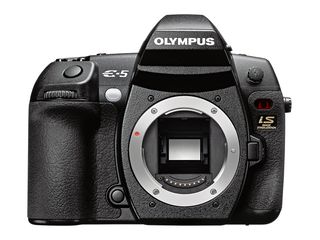Why you can trust TechRadar

Although Olympus likes to bandy the word professional around in connection with the E-5, like Nikon's D300S, it's really more of a semi-pro or serious enthusiast level model. Its build quality, however, is very high, it is splash-and dust-proof and it feels tough enough to survive the rigours of semi-professional use.
From the rear the Olympus E-5 body is quite angular looking with lots of straight lines, however, it is very comfortable to hold with plenty of grippy-textured patches that help keep it safe in your grasp.
Moving up from a 2.5-inch LCD on the E-3 to a 3-inch device on the Olympus E-5 body means that some button rearrangement has taken place and the buttons that are beneath the E-3's LCD have been redistributed above and also the right of the Olympus E-5's screen.
On the whole, the E-5's controls are logically laid out and sit within easy reach, but there are a few quirks. Those with small hands may find the rear control dial a bit of a reach with their thumb, especially when their index finger is on the heavily recessed exposure compensation button on the top plate.
As with other Olympus cameras, namely the E-series DSLRs and the Pen micro system series, it is odd that the manufacturer chooses to bury the option to set JPEG files to the highest quality via the custom menu. Why this isn't located with the other image quality options in the first page of the shooting menu is a mystery. I'm sure many Olympus cameras shoot Fine Quality JPEG images for quite some time before they discover the Extra Fine option.
On the subject of the E-5's menu, Olympus has added coloured tabs to the custom menu options, but the overall look is quite dated. Unlike Nikon and Canon cameras, there's no option to allocate a selection of frequently used menu features to a 'My menu' type screen. Also, there is some wasted free space in the first two shooting menus, that could be used more sensibly to house one or two of the custom options. Why are the metering and white balance options located in the custom menu for instance?
Although the Olympus E-5 has a fair smattering of direct control buttons the LCD can also display the Super Control Panel which allows the user to select and adjust up to 20 settings using the navigation and OK buttons. It's quick and easy to use (even if there is quite a bit of button pressing) and is a great way of assisting those progressing up from Olympus's other cameras. It would be nice if it were possible to customise the display though.
Like the E-3 before it, the Olympus E-5 doesn't really deliver the smaller camera promise made for the Four Thirds format. It is similar in size to the Canon EOS 7D and Nikon D300S, yet it has a smaller sensor. Olympus's retort to this comment is that the Four Thirds lenses are near telecentric, so the light rays hit the sensor at an angle that is very close to perpendicular, which helps to improve image quality and reduce vignetting.
We certainly found there was a significant improvement in image quality when we switched from shooting our lab charts with our standard Sigma 50mm f/1.4 lens to using Olympus's Zuiko Digital ED 12-60mm f/2.8-4.0 SWD optic. This is mostly likely because Olympus's lenses have a near telecentric design and are specifically designed for use with Four Thirds sensors.
The lenses are also subject to a 2x focal length magnification factor, making the Four Thirds system a great option for telephoto lovers, but less popular with wideangle enthusiasts.
Current page: Olympus E-5: Build quality and handling
Prev Page Olympus E-5: Overview Next Page Olympus E-5: Controls and features
